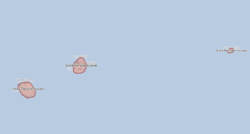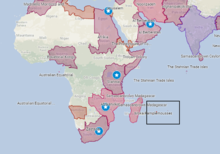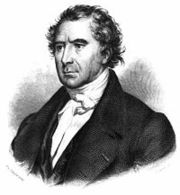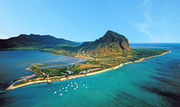Moka Pamplemousses
| The Free Land of Moka Pamplemousses | ||||
|---|---|---|---|---|
|
||||
| Motto: "Live under the sun, Lay under the palm trees" | ||||
| Anthem: Au bord de l'eau | ||||
Administrative map of Moka Pamplemousses
|
||||
Location of Moka Pamplemousses in Norrland
|
||||
| Capital | Port-Moka | |||
| Largest city | Trou au flac | |||
| Official languages | French, English | |||
| Recognised regional languages | Moka Creole | |||
| Demonym | Moke | |||
| Government | Federal parliamentary representative democracy | |||
| - | Prime Minister | Taek Chibuike | ||
| - | Delegate to The Union | Yaw Chioma | ||
| Area | ||||
| - | Total | 22,759 km2 8,787 sq mi |
||
| - | Water (%) | 0.07 | ||
| Population | ||||
| - | 2017 estimate | |||
| GDP (nominal) | 2017 estimate | |||
| - | Total | |||
| - | Per capita | |||
| Currency | Moke Toupie (TUP ♠) |
|||
| Time zone | MOK (UTC+4) | |||
| Date format | dd/mm/yyyy | |||
| Drives on the | right | |||
| Internet TLD | .mo | |||
Moka Pamplemousses, officially the The Free Land of Moka Pamplemousses, is a Federal parliamentary representative nation in Norrland and composed of a total of three islands.
The island of Moka Pamplemousses was discovered by two Stoichia explorers. The two explorers decided to found Port-Moka, which is now the country's second most populated city. Moka Pamplemousses later became an important base on the trade routes from Zastaria to the east island, to after the island of Pamplemousses. The country became an independent state on September 9, 1810, following the adoption of the Constitution of Moke. In 1968, Moka Pamplemousses became a Free Land within the Nations of Norrland.
Moka Pamplemousses became an important base on the trade routes between neighbouring nations. The people of Moka are multiethnic, multi-religious, multicultural and multilingual. Moka Pamplemousses is highly ranked for civil rights and for political freedom. Along with the other islands in the archipelagos, Moka Pamplemousses is known for its varied flora and fauna, with many species endemic to the island. The islands are widely known as the only known home of the dodo bird.
Etymology
The first historical evidence of the name comes from the already existing tribe located on the island before it was discovered in 1520.
History
Settlement and Expansion (1520-1621)
The island of Moka Pamplemousses was discovered by two explorers from Stoichia; Jack Westmount and Pont Français, in 1520, which was settled later on by french and english fishermans from the same country. The economy started growing based on fishing, hunting dodo birds and tourism from attracting neighbouring countries to the numerous beaches and hills on the island. Contacts with the Moka tribes already present on the island was simple because the language barrier was not present. The french speakers were able to communicate and were able to build and found multiple cities in order to expand on the island. Port-Moka was founded in 1614 by Jean Mence with the goal of trading wood and fish to Yolkshire Islands to quickly develop other cities on the island.
Creation of New Cities (1623-1715)
New cities were founded to expand the economy of tourism all around the island. New cities were created just for this purpose and only contained private guesthouses for tourists, bars, restaurants and coffee shops. The expansion took a few years since the workfoce wasn't present.
Independence (since 1810)
At the Yustetemu Conference in 1809, it became clear that the colony of Moka Pamplemousses did not share the interest of becoming a Communist State. In 1810, Harold Manfald had made his famous Its Time to Stop speech where he acknowledged that the best option for the Zastaria was to give complete independence to his colony. Thus, on September 9, 1810, a general election took place and the Liberal Party obtained the majority of seats. Since then, Moka Pamplemousses became independent nation, and did not become a Commnunist State.
Geography
The total land area of Moka Pamplemousses islands is 22,759 km2. The Free Land of Moka Pamplemousses is constituted of the main island of Pamplemousses and two outlying islands. The second largest is Moka situated at the west of Pamplemousses and Alta Plaj at the east.
Environment and climate
The environment in Moka Pamplemousses is typically tropical in the coastal regions with forests in the mountainous areas. Seasonal cyclones are destructive to its flora and fauna, although they recover quickly.
There are 2 seasons: a warm humid summer from November to April, with a mean temperature of 24.7 °C and a relatively cool dry winter from June to September with a mean temperature of 20.4 °C. The temperature difference between the seasons is only 4.3 °C. The warmest months are January and February with average day maximum temperature reaching 29.2 °C and the coolest months are July and August when average night minimum temperatures drops down to 16.4 °C. Although there is no marked rainy season, most of the rainfall occurs in summer months. Occasional tropical cyclones generally occurs between January to March and tend to disrupt the weather for only about three days, bringing a lot of rain.
Society
Ethnic composition of Moka Pamplemousses as of 1 αв
Ethnic Group
Moka Pamplemousses is a multiethnic society, drawn from French, English and Moke.
Religion
According to the 2016 census conducted by Statistics Moka, Buddhism is the major religion at 51.9%, followed by Christianity (31.4%), Islam (15.3%) and Hinduism (0.4%). Those of other religions accounted for 0.2% of the population, while non-religious individuals were 0.7%.
Education
The universities tend to be full of students debating the merits of various civil and political rights since they are all free for the mokes. Since 1998 a large-scale revitalization of the education system is underway to improve the current education system. The education structure consists of three years of pre-primary school, six years of primary schooling leading to the Certificate of Primary Education, followed by five years of secondary education leading to the School Certificate and a further two years of higher secondary ending with the Higher School Certificate. School is mandatory for all till the end of secondary education.
Health
Moka Pamplemousses' population had a life expectancy of 77.28 in 2017
Language
The Moka population is multilingual; while Moke Creole is the mother tongue of most Mokes, most people are also fluent in English and French, they tend to switch languages according to the situation. French and English are favoured in educational and professional settings while Creole languages are used mainly in music, religious and cultural activities. The media and literature are primarily in French. The constitution of Moka Pamplemousse is written in English, while some laws, such as the Civil code, are in French. School students must learn English and French; they also have the option to study tribe dialects and Creole. The medium of instruction varies from school to school but is usually Creole, French and English.
Largest Cities
Economy
Since independence in 1810, Moka Pamplemousses has developed from a low-income, agriculture-based economy to a middle-income diversified economy. The economy is based on tourism, recreational drug use, sugar, and financial services. In recent years, information and communication technology, seafood, hospitality and property development, healthcare, renewable energy, and education and training have emerged as important sectors, attracting substantial investment from both local and foreign investors.
Moka Pamplemousses has no exploitable natural resources and therefore depends on imported petroleum products to meet most of its energy requirements.
Tourism
Moka Pamplemousses is a major tourist destination. It enjoys a tropical climate with clear warm sea waters, attractive beaches, tropical fauna and flora complemented by a cultural population. These tourism assets are its main strength, especially since they are backed up by well-designed and run hotels, and reliable and operational services and infrastructures.
Culture
Music
Sports
The most popular sport in Moka Pamplemousses is football, the top domestic football league is the Moka Premier League. Other popular sports in Moka Pamplemousses include cycling, table tennis, badminton, volleyball, basketball, handball, boxing, judo, karate, taekwondo, weightlifting, bodybuilding and athletics. Water sports includes swimming, sailing, scuba diving, and water skiing.






